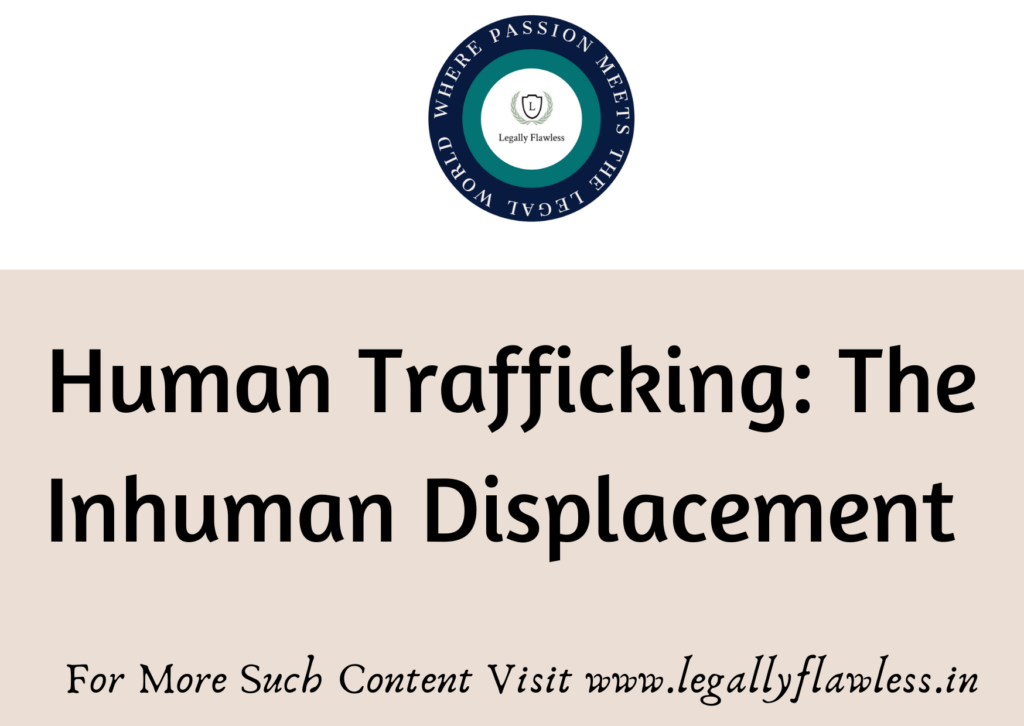
Table of Contents
Abstract
Human rights are the pivot around which human trafficking and its laws are developed. In the simplest sense, human trafficking means the illegal, involuntary transportation of a person from one place to the other. This blog dwells deeply into the problem and breaks it down into major issues which are primarily India centric. It highlights legislation developed by the government of India regarding human trafficking as well as certain important judgments on this sensitive matter. The blog exhaustively describes the human side of human trafficking with examples from areas like northeast India, which the governments have always tried to brush under the carpet to prevent Pandora’s Box from opening. The blog analyses the violation of the fundamental right to life and dignity in the light of human trafficking and gives a glimpse of other associated crimes like bride trade, forced sexual labour and bonded labour.
Introduction
Human trafficking is a sore wound in modern civilization, an offence against humanity and justice. It is a classified form of modern slavery and is now also a part of organized crime. It is not only inclusive of physical abuse but also leads to mental and social prosecution. Today we have a pressing need to discuss this grievous offense as according to the National crime records bureau 2019 report 2260cases of human trafficking were reported and this number keeps on increasing with each passing day encompassing in itself innocent lives, vulnerable due to societal Malfunctioning.
To reduce human trafficking UN has listed a few countries as tier 3 countries that are the worst hit by the menace of human trafficking and require immediate attention for improving conditions. Russia in order to expand its bilateral relations with North Korea has allowed labor camps for workers within Russian borders, this activity has promoted human trafficking and has thus pushed Russia along with China, Iran, Belarus, and Venezuela into the 3-tier list.
Causes and Modes of Human Trafficking
In today’s fast paced world there are innumerable reasons and causes for human trafficking. Not only do they change from country to country but also vary in intensity with a change in state and location. Causes for human trafficking are influenced by social economic and cultural factors.
One of the most dominant causes ofhuman trafficking is the urge of the poor and down trodden to migrate and improve their living conditions. This desire to migrate is not only limited to the marginalized section of society but also to individuals who immigrate to foreign countries and more prosperous societies. This migration is characterized by initial corporation replaced by more repressive means when the person gets dependent on the facilitator. There can be various reasons for migrations; major reasons which promote this dominant reason are poverty, oppression, lack of human rights and political instability.
Children and majorly females are more vulnerable to human trafficking. Destabilization and displacement are seen as major reasons which force vulnerable kids into the mud of human trafficking, some parents not only for money but also, in the hope of a better and secured future fortheir children sell their kids to these organizations dealing with human trafficking.
One of the most prominent social factors which aid human trafficking is the male chauvinist society, the devaluation of women combined with the objectification of them and seeing them as property are all characteristic features of a patriarchal society. This Low-key treatment and lack of respect experienced by female members of the society often forces them to be at the mercy of these traffickers. ill managed Borders, corrupt governments, International organized criminal groups, lack of adequate legislation and political will are some of the political reasons favoring human trafficking.
Transporters usually use modes of addiction todrugs, and allurement of opportunity as ways of persuading people to get into this vicious cycle. Bride trade, demand for cheap labor, need for sexual labor, and lack of education are other reasons which promote this practice of human trafficking in the interiors of India. Many people join this industry as facilitators or transporters, the main reason for which they join this industry is the huge margin or the large profit offered by this work.
Government Initiatives to combat Human Trafficking
Initiatives by Ministries
The Ministry of Home affairs has initiated anti trafficking nodal centers in various States, the centers are effectively working in the states like Assam, Maharashtra, Andhra Pradesh and many more places. These centers have led to the formation of integrated anti human trafficking units (IAHTU). These units are a unique structure to ensure cooperation between various units of government in order to protect the structure of human protection. These units act as a relay center between the police department, development department and civil society. Composition of the department comprises sensitive officers and NGOs. It is for the better functioning of these departments that grants are provided for post rescue cases, for electronics support in terms of computer systems and transportation assistance by the provision of vehicles.
The ministry of labor and employment has implemented various legislation for the reduction of human trafficking, they have implemented the Child Labor (Prohibition and Regulation) Act, 1986 which prohibits the employment of children under the age of 14 in hazardous activities. It is through this legislation that they aim at reducing the number of children trapped in human trafficking as often children are abducted for forceful employment in hazardous industries for example bangle making industry, the firecracker-based industry.
The ministry of women and child development has initiated for protection of human trafficking victim’s various schemes, ujjawala scheme is one of them which focuses on rehabilitation and reintegration of victims who were employed in the inhuman activity of commercial sex, swadhar and short stay home scheme is also an initiative by the ministry to provide housing food and shelter facilities to the victims majorly women and children.
Legislative Safeguards against Human Trafficking
Bonded labor system (abolition) act, 1976 was enacted for the abolition of physical, mental and social exploitation of laborers and to protect them from bonded labor. This act also provides for a punishment ranging from imprisonment up to 3 years to a fine up to 2000 rupees for an act thatcan be considered as bonded labor according to sections 16 and 17 of this act .
Indecent representation of women (prohibition) Act, 1986 according to section 3 of this act nobody should publish any form of material which promotes human trafficking of women as these terms are inclusive in the definition of as given in the act the landmark judgement of State of Bombay v. RMD chamarbaugwala the supreme court found that an illegal or indecent trade does not come within the meaning of trade commerce or inter.
Human trafficking in India is also prohibited by the means of the constitution. As the Indian constitution through fundamental rights guarantees certain human rights and therefore leads to the protection of people from the inhuman act of trafficking, article 21 of the Indian constitution protects life and personal liberty, and article 23 of the Indian constitution ensures prohibition of trafficking of human beings and forced labor. It is by the interplay of both these rights that an individual is protected from human trafficking and can seek remedies for its violation. The Indian penal code protects from sexual exploitation under section 366a IPC, section 366 b, section 370 a and section 374.
Section 366a IPC deals with inducement of a minor girl under the age of 18 years for any kind of illicit intercourse, this section makes this activity a punishable offense. Section 366 b of the IPC deals with importing any girl under the age of 21 years only for the motive of illicit intercourse with another person, the person who will be indulged in such an activity will be punishable by this section. Section 370 of IPC defines the offense of trafficking while section 374 deals with unlawful compulsory labor which can also be bonded labor. In the case of People’s union for democratic rights v. union of India the supreme court defined the meaning of force labor.
Juvenile Justice (Care and protection of child) Act 2000 is also key legislation made for the protection of vulnerable kids, Karnataka devadasi (Prohibition of dedication) Act, 1982 also protects any girl with or without consent of the dedicated person engaging her in activities related to illicit sexual exploitation. Goa children’s act, 2003 is an act Solely dealing with trafficking and sexual exploitation this act also includes in its ambit sexual assault and takes into account managers and owners of these trafficking gangs.
Conclusion
Human trafficking is a problem that is not easily understood by society, though laws have been made extensively to cover the wide gamut of crimes that take place under the umbrella word of human trafficking.
To fulfil simple human needs of food, shelter and survival the victims of human trafficking become easy prey to the vulturous eyes of the organised criminals who are ready to set bait and set in motion a sinister system that leads to a lifetime of misery for the victims.
Today organisations around the world are working tirelessly to bring relief to such victims and to prevent innocent lives from being shattered by the ravages of human trafficking. Vigilant enforcement agencies, supported with well-equipped and stringent law-making machines are trying to bring cases of human trafficking down to a minimum level, but the greed of a few and the compulsions of others is creating a challenge unfathomable to deal with.
Clear understanding and deep awareness of the problem, along with micro management of loopholes with continuous improvement at strategic level can generate confidence and motivation in the community of warriors fighting this battle for humanity and human dignity.
This article is authored by Sukriti Mathur, student at Lloyd Law College.



I believe that covert operations to study human trafficking outfits may also provide an avenue for curbing this inhumane activity. Covert operations have the advantage of providing insider information and allowing methodical processes aimed at its stoppage.